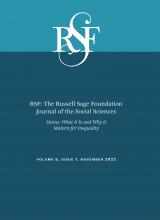Research Article
Open Access
Do Perceptions of Privilege Enhance—or Impede—Perceptions of Intelligence? Evidence from a National Survey Experiment
Natasha Quadlin
RSF: The Russell Sage Foundation Journal of the Social Sciences November 2022, 8 (7) 48-69; DOI: https://doi.org/10.7758/RSF.2022.8.7.03
Natasha Quadlin
aAssociate professor of sociology and faculty fellow in the California Center for Population Research at the University of California, Los Angeles, United States

REFERENCES
- ↵
- Aisch, Gregor,
- Larry Buchanan,
- Amanda Cox, and
- Kevin Quealy
- ↵
- Arcidiacono, Peter,
- Josh Kinsler, and
- Tyler Ransom
- ↵
- Bartz, Kevin
- ↵
- Bénabou, Roland, and
- Jean Tirole
- ↵
- Berger, Joseph,
- Bernard P. Cohen, and
- Morris Zelditch
- ↵
- Bero, Tayo
- ↵
- ↵
- Blau, Peter M., and
- Otis Dudley Duncan
- ↵
- Bonilla-Silva, Eduardo
- ↵
- Bourdieu, Pierre
- ↵
- Calarco, Jessica McCrory
- ↵
- Castro, Abril
- ↵
- Conwell, Jordan A
- ↵
- Conwell, Jordan A., and
- Natasha Quadlin
- ↵
- Conwell, Jordan A., and
- Leafia Zi Ye
- ↵
- Crabtree, Charles, and
- Volha Chykina
- ↵
- ↵
- Cullen, Jim
- ↵
- DiMaggio, Paul
- ↵
- ↵
- DiPrete, Thomas A., and
- Gregory M. Eirich
- ↵
- Doan, Long,
- Natasha Quadlin, and
- Brian Powell
- ↵
- Dynarski, Susan
- ↵
- Eagly, Alice H., and
- Linda L. Carli
- ↵
- Erikson, Robert, and
- John H. Goldthorpe
- ↵
- Ermish, John,
- Markus Jäntti, and
- Timothy M. Smeeding
- ↵
- Espenshade, Thomas J. and
- Chang Y. Chung
- ↵
- Fiske, Susan T.,
- Amy J. C. Cuddy,
- Peter Glick, and
- Jun Xu
- ↵
- Gaddis, S. Michael
- ↵
- Gaddis, S. Michael
- ↵
- Galperin, Roman V.,
- Oliver Hahl,
- Adina D. Sterling, and
- Jerry Guo
- ↵
- Glick, Peter, and
- Susan T. Fiske
- ↵
- ↵
- Hochschild, Jennifer L
- ↵
- Hout, Michael
- ↵
- Jaschik, Scott
- ↵
- Jost, John T.,
- Mahzarin R. Banaji, and
- Brian A. Nosek
- ↵
- ↵
- Kluegel, James R., and
- Eliot R. Smith
- ↵
- Koenig, Biko
- ↵
- Massey, Douglas S.,
- Camille Z. Charles,
- Garvey Lundy, and
- Mary J. Fischer
- ↵
- McCall, Leslie
- ↵
- McCall, Leslie,
- Derek Burk,
- Marie Laperrière, and
- Jennifer A. Richeson
- ↵
- McNamee, Stephen J., and
- Robert K. Miller
- ↵
- Medina, Jennifer,
- Katie Benner, and
- Kate Taylor
- ↵
- Merton, Robert K
- ↵
- Mijs, Jonathan J. B
- ↵
- O’Brien, Timothy L., and
- Shiri Noy
- ↵
- ↵
- Pedulla, David S
- ↵
- Pfeffer, Fabian T
- ↵
- Pfeffer, Fabian T., and
- Alexandra Killewald
- ↵
- ↵
- Quadlin, Natasha
- ↵
- Quadlin, Natasha
- ↵
- Quadlin, Natasha, and
- Jordan A. Conwell
- ↵
- Quadlin, Natasha, and
- Brian Powell
- ↵
- Ray, Rashawn
- ↵
- Reardon, Sean F
- ↵
- Ridgeway, Cecilia L
- ↵
- Ridgeway, Cecilia L., and
- Shelley J. Correll
- ↵
- Risman, Barbara J., and
- Myra Marx Ferree
- ↵
- Rivera, Lauren A
- ↵
- ↵
- Sewell, William H.,
- Archibald O. Haller, and
- Alejandro Portes
- ↵
- Stevens, Mitchell L
- ↵
- Streib, Jessi
- ↵
- Valentino, Lauren
- ↵
- VanHeuvelen, Tom, and
- Natasha Quadlin
- ↵
- Weisshaar, Katherine,
- Koji Chavez, and
- Tania Cabello-Hutt
- ↵
- Wildeman, Christopher,
- Kris Scardamalia,
- Elizabeth G. Walsh,
- Rourke L. O’Brien, and
- Bridget Brew
- ↵
- Young, Michael
In this issue
Do Perceptions of Privilege Enhance—or Impede—Perceptions of Intelligence? Evidence from a National Survey Experiment
Natasha Quadlin
RSF: The Russell Sage Foundation Journal of the Social Sciences Nov 2022, 8 (7) 48-69; DOI: 10.7758/RSF.2022.8.7.03
Jump to section
Related Articles
- No related articles found.
Cited By...
- No citing articles found.





